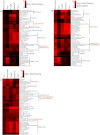Global comparisons of lectin-glycan interactions using a database of analyzed glycan array data
- PMID: 23399549
- PMCID: PMC3617327
- DOI: 10.1074/mcp.M112.026641
Global comparisons of lectin-glycan interactions using a database of analyzed glycan array data
Abstract
Lectin-glycan interactions have critical functions in multiple normal and pathological processes, but the binding partners and functions for many glycans and lectins are not known. An important step in better understanding glycan-lectin biology is enabling systematic quantification and analysis of the interactions. Glycan arrays can provide the experimental information for such analyses, and the thousands of glycan array datasets available through the Consortium for Functional Glycomics provide the opportunity to extend the analyses to a broad scale. We developed software, based on our previously described Motif Segregation algorithm, for the automated analysis of glycan array data, and we analyzed the entire storehouse of 2883 datasets from the Consortium for Functional Glycomics. We mined the resulting database to make comparisons of specificities across multiple lectins and comparisons between glycans in their lectin receptors. Of the lectins in the database, viral lectins were the most different from other organism types, with specificities nearly always restricted to sialic acids, and mammalian lectins had the most diverse range of specificities. Certain mammalian lectins were unique in their specificities for sulfated glycans. Simple modifications to a lactosamine core structure radically altered the types of lectins that were highly specific for the glycan. Unmodified lactosamine was specifically recognized by plant, fungal, viral, and mammalian lectins; sialylation shifted the binding mainly to viral lectins; and sulfation resulted in mainly mammalian lectins with the highest specificities. We anticipate that this analysis program and database will be valuable in fundamental glycobiology studies, detailed analyses of lectin specificities, and practical applications in translational research.
Figures




Similar articles
-
Determining lectin specificity from glycan array data using motif segregation and GlycoSearch software.Curr Protoc Chem Biol. 2013;5(2):157-69. doi: 10.1002/9780470559277.ch130028. Curr Protoc Chem Biol. 2013. PMID: 23839995 Free PMC article.
-
A motif-based analysis of glycan array data to determine the specificities of glycan-binding proteins.Glycobiology. 2010 Mar;20(3):369-80. doi: 10.1093/glycob/cwp187. Epub 2009 Nov 29. Glycobiology. 2010. PMID: 19946132 Free PMC article.
-
Automated motif discovery from glycan array data.OMICS. 2012 Oct;16(10):497-512. doi: 10.1089/omi.2012.0013. Epub 2012 Aug 9. OMICS. 2012. PMID: 22877213 Free PMC article.
-
Using lectins in biomarker research: addressing the limitations of sensitivity and availability.Proteomics Clin Appl. 2012 Aug;6(7-8):346-50. doi: 10.1002/prca.201200014. Proteomics Clin Appl. 2012. PMID: 22927350 Free PMC article. Review.
-
Lectins and ELLSA as powerful tools for glycoconjugate recognition analyses.Glycoconj J. 2019 Apr;36(2):175-183. doi: 10.1007/s10719-019-09865-3. Epub 2019 Apr 16. Glycoconj J. 2019. PMID: 30993518 Review.
Cited by
-
Exploration of sialic acid diversity and biology using sialoglycan microarrays.Biopolymers. 2013 Oct;99(10):650-65. doi: 10.1002/bip.22314. Biopolymers. 2013. PMID: 23765393 Free PMC article. Review.
-
Characterizing Protein Glycosylation through On-Chip Glycan Modification and Probing.Anal Chem. 2016 Dec 6;88(23):11584-11592. doi: 10.1021/acs.analchem.6b02998. Epub 2016 Nov 15. Anal Chem. 2016. PMID: 27809484 Free PMC article.
-
Current Concepts on 6-sulfo LacNAc Expressing Monocytes (slanMo).Front Immunol. 2019 May 22;10:948. doi: 10.3389/fimmu.2019.00948. eCollection 2019. Front Immunol. 2019. PMID: 31191513 Free PMC article. Review.
-
Coupling Mass Spectrometry-Based "Omic" Sciences with Bioguided Processing to Unravel Milk's Hidden Bioactivities.J Adv Dairy Res. 2013 Jul 24;1(2):104. doi: 10.4172/2329-888X.1000104. J Adv Dairy Res. 2013. PMID: 24818172 Free PMC article.
-
Glycan motif profiling reveals plasma sialyl-lewis x elevations in pancreatic cancers that are negative for sialyl-lewis A.Mol Cell Proteomics. 2015 May;14(5):1323-33. doi: 10.1074/mcp.M114.047837. Epub 2015 Mar 2. Mol Cell Proteomics. 2015. PMID: 25733690 Free PMC article.
References
-
- Crocker P. R., Paulson J. C., Varki A. (2007) Siglecs and their roles in the immune system. Nat. Rev. Immunol. 7, 255–266 - PubMed
-
- van Kooyk Y., Rabinovich G. A. (2008) Protein-glycan interactions in the control of innate and adaptive immune responses. Nat. Immunol. 9, 593–601 - PubMed
-
- Rudd P. M., Elliott T., Cresswell P., Wilson I. A., Dwek R. A. (2001) Glycosylation and the immune system. Science 291, 2370–2376 - PubMed
Publication types
MeSH terms
Substances
Grants and funding
LinkOut - more resources
Full Text Sources
Other Literature Sources

